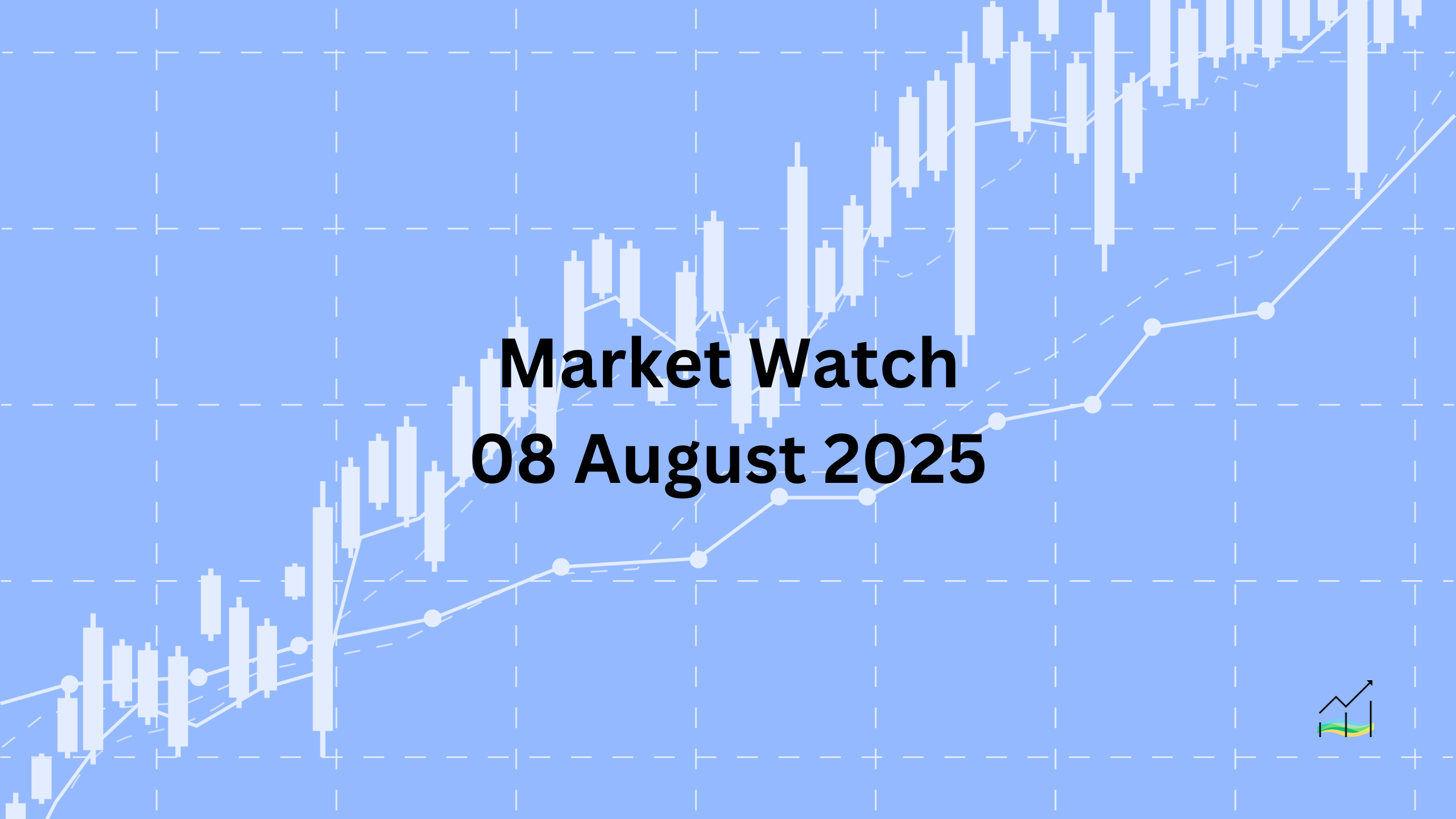08/08/2025 Market Watch

Tariffs Stir Gold, Dollar Recovers Post-Fed Nomination
Key Takeaways:
- US dollar recoups most losses following Fed nomination developments.
- Gold markets disrupted by unexpected US tariffs on bullion bars.
- China CPI data due tomorrow, US July CPI in focus next week.
- Asian equities broadly weaker, Europe steady, US futures firmer.
- Treasury and Gilt yields diverge, oil rebounds after a sharp drop.
The US dollar staged a recovery today, reversing much of yesterday's slide that followed the White House's endorsement of Stephen Miran to fill a Federal Reserve board seat. With ranges generally narrow, the greenback is trading firmer across most G10 currencies, with the Canadian dollar and British pound as exceptions. The dollar is also gaining ground against a range of emerging market currencies. Traders are turning their focus to China's consumer and producer price index figures set for release tomorrow, while the US July CPI data next week is expected to confirm a third consecutive monthly increase.
Market attention temporarily shifted to the gold sector after US Customs unexpectedly imposed tariffs on one-kilogram and 100-ounce gold bars, which had previously been exempt. This created confusion and volatility in futures trading, with speculation that a clerical mistake may have been made. Despite the uncertainty, spot gold is holding firm, approaching the $3400 mark. A higher close today would mark the sixth gain in seven sessions.
In the equity space, most major Asia Pacific markets posted losses today, paring gains made earlier in the week. India’s stock market declined significantly, pressured by new US tariffs that include a 50% rate on Indian goods, pulling weekly performance into negative territory. European equities are more stable, with the Stoxx 600 showing modest midday gains. If held, this would be the fourth rise this week, nearly erasing last week's 2.6% drop. US index futures are also showing mild strength.
Bond markets presented a mixed picture. European benchmark 10-year yields are up slightly by 1 to 2 basis points, while UK Gilts reached weekly highs with the 10-year yield touching 4.57%. In contrast, US Treasury yields edged slightly lower, with the 10-year yield just below 4.25%, though still about five basis points higher for the week. In commodities, September WTI crude briefly broke below last month’s low at $63.20 before rebounding above $64.00. Today also marks the deadline set by former President Trump for Russia to respond to a proposed ceasefire, adding another geopolitical thread to the market narrative.
United States of America
Overview
The US dollar’s recent rally from early July to the start of August has begun to unwind, with this week’s pullback nearly reaching the 61.8% retracement level of the move. The Dollar Index is now stabilising just below yesterday’s high, following a dip triggered by reports that Stephen Miran may be nominated to serve the remainder of Governor Kugler’s Federal Reserve term. Market participants are also speculating on who will succeed Chair Powell, with Waller viewed as a frontrunner.
The US economic calendar is light until next Tuesday, when July CPI data is due. Both headline and core inflation are expected to have increased for the third straight month, reinforcing market expectations of a shift in monetary policy. A consensus is forming around the possibility of a rate cut at the next FOMC meeting on 17 September. Fed funds futures are currently pricing in a roughly 90% chance of a September cut, a sharp increase from the sub-40% probability before last week’s jobs data. The market now projects the year-end effective Fed funds rate at 3.74%, down from 4% prior to the employment report, and significantly below the current average rate of 4.33%.
Economic Drivers
- Dollar retreat follows a strong July rally and speculation around Fed appointments.
- Inflation momentum continues, with July CPI expected to extend the upward trend.
- Markets sharply reassess rate cut probabilities after weak employment data.
- Current policy rate remains elevated, but futures suggest significant easing by year-end.
Data and Events
- 08 August 2025: 30-y Bond Auction
- 08 August 2025: Consumer Credit
Price Action
- Dollar Index is consolidating below 98.50 after nearing a key retracement level.
- Yesterday’s low was set during the North American session following Fed speculation.
- Futures pricing reflects growing confidence in near-term Fed easing.
Key Points:
- Dollar Index consolidates after a strong month-long rally.
- Miran nomination and Waller succession speculation weigh on sentiment.
- CPI data and rate cut odds dominate market focus ahead of the FOMC.
- Fed funds futures imply a substantial policy shift by year-end.
- Monetary expectations are now more dovish following labour market softness.
Canada
Overview
The Canadian dollar is trading near key support levels as the market awaits the release of July employment data. The US dollar is holding just above the CAD1.3725 zone, which aligns with both the 20-day moving average and the 50% retracement of the rally from the July 23 low near CAD1.3575. Resistance is situated near this week's high around CAD1.3810, while the greenback remains close to yesterday's lows.
Canada's labour market data is the main focus heading into the weekend. In the first half of 2025, the economy added nearly 144,000 jobs, down from 183,000 in the same period last year. Within that figure, full-time job creation stands at roughly 56,000, compared to 66,000 in H1 2024. For July, the median forecast calls for a modest 10,000 job gain, a significant slowdown from June’s 83,100. If realised, the unemployment rate may rise back to 7%, matching the post-pandemic peak seen in May. Despite today's data release, rate expectations remain relatively anchored. The swaps market currently reflects a 30% probability of a rate cut at the 17 September Bank of Canada meeting. Unless the data significantly underperforms, this outlook is unlikely to shift.
Economic Drivers
- Labour market remains a key metric for monetary policy assessment.
- Job creation in H1 2025 lags behind the same period last year.
- Rising unemployment may reflect broader economic softening.
- Rate cut speculation remains contained ahead of employment figures.
Data and Events
- 08 August 2025: Employment Change
- 08 August 2025: Unemployment Rate
Price Action
- USD/CAD holding support at 1.3725, coinciding with 20-day MA and 50% retracement.
- Resistance observed near 1.3810, this week’s high.
- Greenback remains pinned near recent session lows.
Key Points:
- Canadian dollar trades near technical support ahead of labour data.
- Employment growth slows compared to last year.
- Unemployment rate may return to 7%.
- Market sees low probability of a near-term BoC rate cut.
- USD/CAD technicals frame the pre-data trading range.
China
Overview
China’s persistent external surplus, particularly in trade and current account balances, has led to widespread assertions that the yuan is undervalued. However, much of the international pressure for a revaluation overlooks two key considerations. First, the broader foreign exchange market context reveals a more complex picture. While the IMF estimates the yuan to be around 15% below fair value, some analysts suggest the figure could be closer to 20%. Yet, comparative data shows the euro and yen are nearly 55% undervalued, and the Canadian dollar by about 21%, based on purchasing power parity models. Among G10 currencies, only the Swiss franc appears overvalued, by roughly 17%. This suggests the yuan’s perceived undervaluation may be less about China and more about the persistent overvaluation of the US dollar.
The second point often overlooked is the adjustment mechanism itself. Advocates for revaluation rarely specify how central banks, particularly the PBOC, should manage this transition. Suggestions such as selling US Treasuries or raising domestic interest rates ignore China’s broader economic challenges, including deflationary pressures. July inflation figures will be released tomorrow, and they are expected to reinforce this concern. Moreover, despite the dollar’s recent rally, the yuan has outperformed all other emerging market and G10 currencies over the past month, indicating underlying resilience.
Economic Drivers
- China’s trade and current account surpluses contribute to yuan undervaluation arguments.
- IMF and analysts estimate the yuan is 15% to 20% below fair value.
- Broader currency misalignments highlight US dollar overvaluation as a more significant factor.
- Lack of clear strategy from revaluation advocates on implementation.
- Ongoing deflation risk complicates any case for monetary tightening.
Data and Events
- 09 August 2025: CPI
- 09 August 2025: PPI
Price Action
- This week’s offshore yuan range set on Monday between CNH7.1765 and CNH7.1960.
- PBOC reference rate for USD set at CNY7.1382, a new low since November.
- Dollar fix change this week was close to 0.40%, the largest move since last November.
Key Points:
- Yuan undervaluation debate must consider broader FX market context.
- Dollar overvaluation is a central issue often ignored in the revaluation narrative.
- Lack of clear revaluation strategy from policymakers and analysts.
- PBOC’s recent actions suggest cautious management rather than intervention.
- July inflation data will add to deflationary concerns shaping policy decisions.
Japan
Overview
The Japanese yen continues to trade within a well-defined range established earlier in the week, with the dollar fluctuating between JPY146.60 and JPY148.10. Yesterday’s movement nearly covered that span, and the currency remains within that same range today. A notable technical development occurred as the five-day moving average fell below the 20-day moving average for the first time in a month, providing a signal of short-term trend weakness. A break above JPY148.25 would be required to shift market sentiment more decisively.
On the economic front, Japan’s June household spending data showed a year-over-year increase of 1.3%, falling short of expectations and sharply down from May’s 4.7%. Nonetheless, the broader trend shows meaningful improvement. Real household spending had declined consistently from late 2022 through most of 2023, but began to show positive momentum at the start of this year. The first half of 2025 has delivered an average annualised increase of 1.4%, compared to a 1.8% contraction during the same period last year.
The current account surplus narrowed sharply in June to JPY1.35 trillion from JPY3.4 trillion in May. While the trade surplus also declined, from JPY522 billion to JPY470 billion, trade accounted for only a small part of the overall contraction. Market expectations for policy tightening by the Bank of Japan have softened slightly, with swap pricing now reflecting 14 basis points of tightening expected by year-end, down from 15 basis points last week.
Economic Drivers
- June household spending rose less than expected but continues to improve overall.
- Consumption trend has shifted from contraction to modest growth in 2025.
- Current account surplus narrowed significantly, with minimal contribution from trade.
- Market expectations for BoJ tightening have slightly weakened.
Data and Events
- 08 August 2025: Household Spending
- 08 August 2025: BOJ Summary of Opinions
- 08 August 2025: Current Account
Price Action
- USD/JPY is trading within this week’s range of JPY146.60 to JPY148.10.
- Yesterday’s price action nearly covered the full range.
- Five-day MA crossed below 20-day MA, indicating near-term trend softening.
- A move above JPY148.25 would be technically significant.
Key Points:
- Household spending growth continues but missed expectations.
- H1 2025 marks a shift toward modest consumption recovery.
- Current account surplus narrowed, with limited trade impact.
- Market pricing reflects slightly reduced BoJ tightening expectations.
- USD/JPY remains directionless within a well-established range.
United Kingdom
Overview
Sterling extended gains this week following the Bank of England’s latest policy decision, which was interpreted by markets as a “hawkish cut.” The pound rose to nearly $1.3450 after the announcement and managed a marginal new high earlier today. The market response was driven not only by the rate decision itself but also by the voting split. The Monetary Policy Committee’s 5-4 vote, emerging from an earlier three-way division, signalled a more cautious approach to further easing. As a result, expectations for another rate cut in the fourth quarter have been scaled back. At Wednesday’s close, a Q4 cut was fully priced in, but now those odds have declined by more than 25%.
The Bank of England’s statement placed greater emphasis on upside inflation risks, reinforcing the notion that policy may remain restrictive for longer. The rally in sterling gained additional momentum after reports emerged that Stephen Miran could be nominated to the US Federal Reserve, further pressuring the dollar. Sterling has now closed above its 20-day moving average for the first time since late July, reflecting improved sentiment.
Economic Drivers
- Bank of England delivered a rate cut but maintained a hawkish tone.
- Close 5-4 vote signalled policy caution and a higher bar for future cuts.
- BOE emphasised persistent upside inflation risks.
- UK rate expectations for Q4 have been partially unwound by the market.
- Sterling benefited from reduced dollar strength following Fed speculation.
Data and Events
- 08 August 2025: MPC Member Speaks
Price Action
- GBP/USD reached nearly $1.3450 post-BOE decision and set a marginal new high today.
- Closed above the 20-day moving average (~$1.3395) for the first time since 23 July.
- The $1.3465 level represents the 50% retracement of last month’s decline.
- Next resistance is near $1.3540, the 61.8% retracement of the same move.
Key Points:
- BOE’s rate cut accompanied by a hawkish tone drove sterling higher.
- Market scaled back expectations of another rate cut this year.
- Inflation risks remain a key concern for UK policymakers.
- Sterling broke above technical resistance, improving near-term outlook.
- External USD weakness added to GBP/USD momentum.
© 2025 SKONE Enterprise (003319453-V). All rights reserved.
The content on this site is for informational purposes only and does not constitute financial advice.


